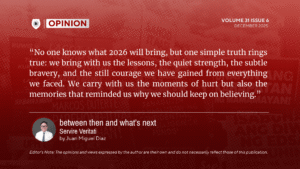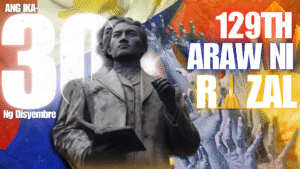By Sophia T. Anillo | July 31, 2025
Is Seeing Still Believing, or Are the Senses Now Deceiving?
IS seeing still believing, or are the senses now deceiving? Eyes are one of the most reliable means of perceiving reality, along with other human senses. It is humanity’s way of embodying intelligence in making real-life decisions. From settling on which news to absorb to opting for which item to purchase, one’s senses are their lending hand in all of life’s facets.
Yet, there seems to be another form of intelligence that is gradually transcending human intelligence—Artificial Intelligence or AI. Indeed, AI has been rewriting the rules of perception. The general public is now dwelling in a world where trusting what one perceives may be a great leap of faith—hence, is to see no longer to believe?
Social media has witnessed the development of trends that mirror the world, some of which are the “Gummy vs Real” and “Real or Cake?” trends. With these, the audience could simply use their eyesight to decipher which variant was real. However, the senses are challenged by the developing phenomenon that has been dominating digital screens, the “Which one is AI?” trend.
AI Surges, Trust Plunges?
The “Which one is AI?” trend requires viewers to discern authentic content from AI-generated imitation, which may lead people to see AI as a deceiver of the senses. This year has seen AI’s capacity to craft high-resolution videos and photographs, which has created dilemmas in a multitude of aspects.
AI’s capacity paved the way for fraudulent acts, such as faking financial transactions. AI is now prompted to create e-slip screenshots for any predetermined amount. Scammers may send ChatGPT authentic BPI and BDO transaction screenshots, prompting it to alter the exhibited amounts. Another instance is how AI can forge documents and personal photos. The wrong hands may exploit this ability, harnessing it as a way to gain access to certain bank accounts. GPT-4o is among the generative models utilized to fabricate official government-issued identity documents, encompassing passports and driver’s licences.
The deception of AI has also reached the professional sphere as it is capable of fabricating online meetings with company members. Scammers once deployed deepfake video software to emulate a Chief of Financial Officer during a live Zoom meeting with ASX-listed Spark New Zealand, mandating the accounts team to release a staggering amount of 1.5 million New Zealand dollars. This substantiates the reality that the fabrication of such videos may lead to abominable scams that can facilitate the loss of millions.
AI also plays a role in voice-cloning, to the detriment of communication integrity in professional circumstances. Any individual may opt for voice-cloning platforms, such as ElevenLabs and Resemble AI, to mimic any vocal sound from a brief audio clip. This, therefore, allows scammers to utilize voices as a way to plausibly trick people into authorizing high-value purchases or transfers.
AI has cast a shadow of doubt even on the most trusted faculties—the senses—leaving doubt on the perception of certain professionals. These are situations that arise when AI falls into the wrong hands.
Unbinding the Mind from AI’s Design
At its core, when AI is misused, it may call into question the authenticity that the senses behold. Though a paramount fact to be retained is that the senses merely send signals to another crucial component of the human body, the brain. It bears the responsibility to interpret these signals that lead to the formulation of a response. This implies that, if humanity trains their brains to be equipped to pinpoint AI, sight could establish grounds to believe once again.
To turn that into a reality, humanity must possess a keen eye in perceiving signs of AI, which include visual and audio cues. AI tends to scramble text in photographs because, regardless of AI knowing the correct look of letters, it is still not capable of consistently knowing how to arrange those letters. In the context of audio, AI possesses an emotionless and monotone voice since it simply works with the data given.
Artificial Intelligence also paved the way for humanity to question their senses because most individuals have reduced their dependence on their innate senses, opting instead for overreliance on AI. The moment humanity learns to perceive AI as a mere lending hand is the moment that humanity will learn how to use it properly, leading to the overreliance being diminished.
However, it is still important to note that AI remains a remarkable advancement within society. Its ease of access permits a broad range of individuals to carry out their daily routines with enhanced speed and efficiency. It may be employed as a grammar checker, schedule crafter, language translator, workout planner, or weather forecaster—these are some ways AI may assist humanity in their day-to-day existence.
This very accessibility mirrors its vulnerability–AI is as easy to use as it is to exploit. AI, essentially, has the immense capacity to help humanity. It may evolve into one of humanity’s most indispensable instruments across diverse aspects of life, provided it is employed properly.
Senses and AI Intertwined
In the unfolding of the digital age, AI is immensely cast in a shadowed light. Human senses—primarily sight—have long been trusted, yet with the rise of AI, that trust is beginning to dwindle. As AI-generated content makes it more difficult to decipher the truth, reality becomes distorted, leaving one uncertain about what to trust. The mere act of disclosing AI use is now often perceived as taboo, as its reputation has become entangled with fraudulent acts.
Nevertheless, humanity must remain vigilant to uncover the silver lining that lies beneath these gloomier aspects. The foundation of this commences with a conscious comprehension of how and when to leverage AI. When human perception is shaped by thoughtful cognition, AI is poised to become one of the foremost lending hands in the daily lives of all. Crucially, it should be viewed as an extension—not a replacement—of humanity’s capacities. To see, in essence, is still to believe—when guided by human senses, not dominated by artificial intelligence.
Volume 31 | Issue 1




